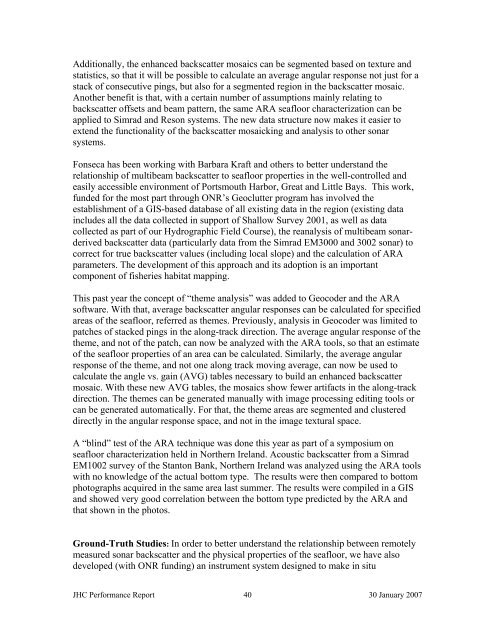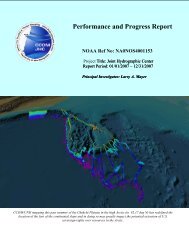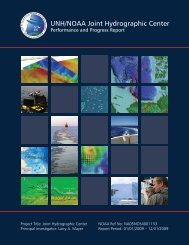Performance and Progress Report - John Doe FIX: put in the authors ...
Performance and Progress Report - John Doe FIX: put in the authors ...
Performance and Progress Report - John Doe FIX: put in the authors ...
Create successful ePaper yourself
Turn your PDF publications into a flip-book with our unique Google optimized e-Paper software.
Additionally, <strong>the</strong> enhanced backscatter mosaics can be segmented based on texture <strong>and</strong><br />
statistics, so that it will be possible to calculate an average angular response not just for a<br />
stack of consecutive p<strong>in</strong>gs, but also for a segmented region <strong>in</strong> <strong>the</strong> backscatter mosaic.<br />
Ano<strong>the</strong>r benefit is that, with a certa<strong>in</strong> number of assumptions ma<strong>in</strong>ly relat<strong>in</strong>g to<br />
backscatter offsets <strong>and</strong> beam pattern, <strong>the</strong> same ARA seafloor characterization can be<br />
applied to Simrad <strong>and</strong> Reson systems. The new data structure now makes it easier to<br />
extend <strong>the</strong> functionality of <strong>the</strong> backscatter mosaick<strong>in</strong>g <strong>and</strong> analysis to o<strong>the</strong>r sonar<br />
systems.<br />
Fonseca has been work<strong>in</strong>g with Barbara Kraft <strong>and</strong> o<strong>the</strong>rs to better underst<strong>and</strong> <strong>the</strong><br />
relationship of multibeam backscatter to seafloor properties <strong>in</strong> <strong>the</strong> well-controlled <strong>and</strong><br />
easily accessible environment of Portsmouth Harbor, Great <strong>and</strong> Little Bays. This work,<br />
funded for <strong>the</strong> most part through ONR’s Geoclutter program has <strong>in</strong>volved <strong>the</strong><br />
establishment of a GIS-based database of all exist<strong>in</strong>g data <strong>in</strong> <strong>the</strong> region (exist<strong>in</strong>g data<br />
<strong>in</strong>cludes all <strong>the</strong> data collected <strong>in</strong> support of Shallow Survey 2001, as well as data<br />
collected as part of our Hydrographic Field Course), <strong>the</strong> reanalysis of multibeam sonarderived<br />
backscatter data (particularly data from <strong>the</strong> Simrad EM3000 <strong>and</strong> 3002 sonar) to<br />
correct for true backscatter values (<strong>in</strong>clud<strong>in</strong>g local slope) <strong>and</strong> <strong>the</strong> calculation of ARA<br />
parameters. The development of this approach <strong>and</strong> its adoption is an important<br />
component of fisheries habitat mapp<strong>in</strong>g.<br />
This past year <strong>the</strong> concept of “<strong>the</strong>me analysis” was added to Geocoder <strong>and</strong> <strong>the</strong> ARA<br />
software. With that, average backscatter angular responses can be calculated for specified<br />
areas of <strong>the</strong> seafloor, referred as <strong>the</strong>mes. Previously, analysis <strong>in</strong> Geocoder was limited to<br />
patches of stacked p<strong>in</strong>gs <strong>in</strong> <strong>the</strong> along-track direction. The average angular response of <strong>the</strong><br />
<strong>the</strong>me, <strong>and</strong> not of <strong>the</strong> patch, can now be analyzed with <strong>the</strong> ARA tools, so that an estimate<br />
of <strong>the</strong> seafloor properties of an area can be calculated. Similarly, <strong>the</strong> average angular<br />
response of <strong>the</strong> <strong>the</strong>me, <strong>and</strong> not one along track mov<strong>in</strong>g average, can now be used to<br />
calculate <strong>the</strong> angle vs. ga<strong>in</strong> (AVG) tables necessary to build an enhanced backscatter<br />
mosaic. With <strong>the</strong>se new AVG tables, <strong>the</strong> mosaics show fewer artifacts <strong>in</strong> <strong>the</strong> along-track<br />
direction. The <strong>the</strong>mes can be generated manually with image process<strong>in</strong>g edit<strong>in</strong>g tools or<br />
can be generated automatically. For that, <strong>the</strong> <strong>the</strong>me areas are segmented <strong>and</strong> clustered<br />
directly <strong>in</strong> <strong>the</strong> angular response space, <strong>and</strong> not <strong>in</strong> <strong>the</strong> image textural space.<br />
A “bl<strong>in</strong>d” test of <strong>the</strong> ARA technique was done this year as part of a symposium on<br />
seafloor characterization held <strong>in</strong> Nor<strong>the</strong>rn Irel<strong>and</strong>. Acoustic backscatter from a Simrad<br />
EM1002 survey of <strong>the</strong> Stanton Bank, Nor<strong>the</strong>rn Irel<strong>and</strong> was analyzed us<strong>in</strong>g <strong>the</strong> ARA tools<br />
with no knowledge of <strong>the</strong> actual bottom type. The results were <strong>the</strong>n compared to bottom<br />
photographs acquired <strong>in</strong> <strong>the</strong> same area last summer. The results were compiled <strong>in</strong> a GIS<br />
<strong>and</strong> showed very good correlation between <strong>the</strong> bottom type predicted by <strong>the</strong> ARA <strong>and</strong><br />
that shown <strong>in</strong> <strong>the</strong> photos.<br />
Ground-Truth Studies: In order to better underst<strong>and</strong> <strong>the</strong> relationship between remotely<br />
measured sonar backscatter <strong>and</strong> <strong>the</strong> physical properties of <strong>the</strong> seafloor, we have also<br />
developed (with ONR fund<strong>in</strong>g) an <strong>in</strong>strument system designed to make <strong>in</strong> situ<br />
JHC <strong>Performance</strong> <strong>Report</strong> 40 30 January 2007




